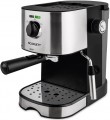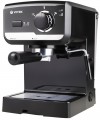Used coffee
Types of coffee for which the coffee maker was originally designed.
—
Ground. Traditional ground coffee; the easiest way is to buy such a product in finished form, but if you wish, you can grind it yourself from whole beans. And if this option is specified for a model with a built-in coffee grinder (see above), this means that both beans and pre-ground coffee can be loaded into it.
—
In grains. This option means that the coffee maker is equipped with a built-in coffee grinder by definition, which means that you can grind beans in it immediately before brewing, which allows you to maximize the taste and aroma. For more information about the other benefits of this option, see "Built-in coffee grinder". Also note here that some coffee makers with this function also allow the use of ground coffee (see above), others work exclusively with beans from their own coffee grinder and do not require loading a powder that was ground separately.
—
Capsules. Ground coffee, packaged in special capsules; usually, one such container is used to prepare one serving of the drink. Capsule coffee makers are extremely simple and easy to use: just load the capsule, turn on the making and wait for the end of the process, and then remove the used container. The capsules themselves can be both disposable and reusable. The advantage of the first option is that the human fac
...tor is eliminated from the brewing process: each capsule contains a standard portion of coffee, and each next cup is no different from the previous one. In addition, disposable containers are hermetically sealed and can be stored for a long time without loss of quality. Their disadvantages are the limited flavors, the high final cost of the drink (almost twice as expensive as using beans or ground coffee), and the fact that different manufacturers of coffee makers use different capsule formats. Reusable capsules can be refilled with ground coffee to your taste, they are cheaper, but not suitable for long-term storage and require thorough cleaning when changing coffee sorts.
— Pods (cialda). A type of portion packaging in which roasted ground coffee is packed in a special filter, most often paper; each such filter is stored in a sealed bag. From a practical point of view, pods are very similar to disposable capsules (see above). On the one hand, the preparation of such coffee is extremely simple, convenient and does not require any special skills: just load the pod, turn on the coffee maker and wait for the preparation; and sealed packaging allows you to store such coffee for a long time. But pods do not allow you to experiment with different sorts, grinding levels and preparing features, and the selection of sorts and flavors among them is rather limited. In terms of one cup of coffee in pods, it is cheaper than a drink from disposable capsules, but still more expensive than coffee from ground beans.
On a separate note some models of coffee makers allow the user to use several types of coffee at once. For example, in the holder of some manual espresso coffee makers (see "Type"), both a portion of ground coffee and a pod can be loaded.Adjustments
—
Grinding degree. Choosing the degree of coffee grinding is crucial for achieving the desired strength and consistency of the final coffee. Different types of coffee drinks require varying degrees of grinding. For espresso and related drinks like cappuccino and latte, a fine grind is necessary. Turkish coffee requires an extremely fine grind, almost like "dust." Cream coffee and filter coffee are best with a medium grind, while a coarse grind works well for French press.
—
Pre-wetting. One option available in some coffee makers is the ability to pre-moisten the ground coffee with hot water before brewing the drink. This feature allows users to customize the duration of coffee wetting, although there may be exceptions. Pre-wetting plays a crucial role in enhancing the taste and aroma of coffee, resulting in a more intense and flavorful beverage. Automatic coffee makers often include this feature.
—
The strength of the drink. Coffee enthusiasts have the option to manually adjust the strength of their beverage. This adjustment can be achieved through various methods, such as changing the coffee-to-water ratio, adjusting the water temperature, or controlling the brewing speed. The number of available settings may vary, ranging from a basic choice between "strong" and "mild" to more advanced options. Regardless of the number of settings, this function allows
...individuals to personalize the taste of their coffee according to their preferences, providing additional customization features.
— Drink volume. Coffee makers offer the feature of selecting the desired volume of the final beverage according to individual preferences. Different models may have varying methods for making this choice. Some machines provide fixed settings (20 mL, 35 mL, etc.) from hich users can select their preferred option. Other models allow for manual adjustment of the volume, sometimes even allowing users to gauge it visually. This feature enables users to customize standard programs to their liking and provides opportunities for experimenting with unique recipes.
— Temperature control. Coffee makers offer the ability to regulate the water temperature for brewing coffee. The taste of the final beverage is heavily influenced by this factor. Higher temperatures result in a brighter and more intense flavor, but excessive heating (96 °C and above) can release compounds from the coffee that add bitterness. The optimal brewing temperature is generally considered to be within the range of 92 — 95 °C. However, coffee makers may provide a wider range of temperature adjustments. Some believe that even a difference of just 1 °C can significantly impact the properties of the coffee, making this adjustment essential for those who appreciate the subtle nuances of taste and aroma in their coffee.
— Steam pressure. Coffee makers offer the feature to adjust the steam pressure coming out of the panarello nozzle. This nozzle is used for frothing milk, especially when preparing cappuccino, as well as for heating milk. By modifying the steam outlet pressure, users can control the intensity of the steam and achieve varying foam densities. It also allows them to omit foam altogether if the intention is solely to heat the milk.
— Foam volume / density. For coffee and milk beverage enthusiasts, the ability to adjust the volume and thickness of the foam "cap" is highly useful. This feature is particularly valuable when preparing drinks like cappuccino, latte, and macchiato. The quality of the final beverage is influenced by the quantity and density of the foam. By customizing these parameters, users can tailor the drink to their personal taste preferences.
— Water hardness. Coffee makers offer the capability to adjust the settings based on the hardness of the water being used. Over time, the heating element of the coffee machine accumulates scale and requires regular cleaning or descaling. The rate of scale buildup increases with harder water, necessitating more frequent cleaning. However, the coffee machine evaluates the condition of the heating element not based on the actual scale amount, but by considering the water hardness setting and the duration of operation since the last cleaning. Therefore, it is crucial to correctly set the water hardness settings to receive timely notifications for descaling. Coffee machines equipped with this feature often include a water hardness indicator with four settings: very soft, soft, hard, and very hard.Water tank
The volume of the water tank provided in the coffee maker; for turkish electric coffee pot (see "Type"), this paragraph indicates the actual working volume of the turk.
The larger the tank, the more coffee you can make without refilling the device; on the other hand, a large capacity, respectively, affects the dimensions, weight and price of the device. Therefore, manufacturers select this parameter in accordance with the general level of the coffee maker and the features of its intended use. So, you rarely have to make more than two cups of coffee at the same time, and 300 – 400 mL for such cases is usually more than enough for home use. And for use in a coffee shop or restaurant, where coffee is made often and in large quantities,
large-sized devices are produced, the volume of which is already calculated in liters; recommendations for choosing the volume of a coffee maker for professional use can be found in special sources.
Pressure
This parameter is relevant for espresso coffee makers and geyser models — where coffee is prepared at increased steam pressure. In the second case, this parameter can be ignored — in "geysers" the extraction of soluble substances from coffee occurs mainly due to high temperature. But for espresso coffee makers, pressure is a key characteristic. All such devices can be divided into two categories. The first is the entry-level models, in which the pressure is only 4 – 5 bar. Such a modest figure is compensated by the high temperature of the steam, due to which the coffee aroma is relatively weak, but quite a lot of caffeine is extracted into the drink. More advanced espresso makers provide
15 bar and even higher (
19 bar and
20 bar); this significantly affects the cost, but the coffee turns out to be as rich and aromatic as possible.
Power consumption
Power consumption of the coffee maker. Usually, this indicator is comparable with the power of the heater installed in the device.
This parameter is selected by the manufacturer, taking into account other performance characteristics (type of device, tank volume, additional functions, etc.), so that the coffee maker can effectively cope with its tasks. Therefore, in fact, power is of secondary importance: it is worth deciding first of all on other practical points, and only then look at power when choosing. In general, a more powerful coffee maker (ceteris paribus) will quickly cope with the preparation of coffee, but it will also cost more.

